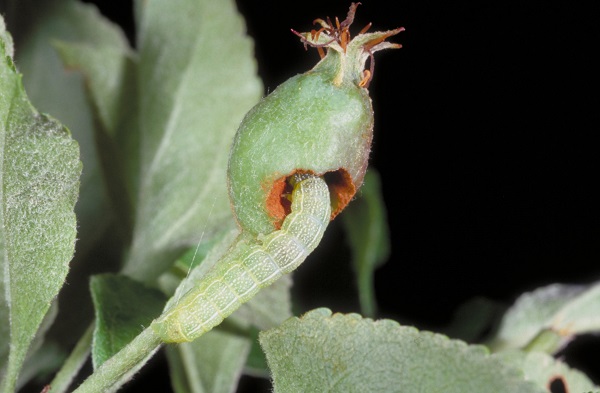Green Fruitworms
ENTFACT-214: Green Fruitworms | Download PDF
by Ric Bessin, Extension Specialist
University of Kentucky College of Agriculture
Speckled Green Fruitworm (Orthosia hibisci)
Green Fruitworm (Lithophane antennata)
Green Fruitworm (Lithophane unimoda)
In Kentucky, there are three species of green fruitworms. However, because they cause similar damage and share like biologies they can be treated as a single pest. These insects feed on the foliage and fruit of a number of deciduous trees. They can cause considerable damage to the fruit of apples, plums, peaches and pears.

Figure 1.Green fruitworm damaging young apple.
Small larvae feed on young foliage initially, buds and blooms later, and finally on the fruit when it becomes available. They cause deep, sunken pits in the fruit. Most of the fruit damaged by these caterpillars fall to the ground by early June. Damaged fruit remaining on the tree has large, sunken, corky wounds at harvest.
In most orchards, green fruitworms are usually kept under control with pink and petal fall sprays targeting other insect pests.
The adults of these pests are light brown 1-inch-long moths with mottled forewings. The larvae are green with numerous white or blue flecks, a thin light colored stripe down the middle of the back and a wider stripe along each side of the body. The robust larvae can reach 1-1/4 to 1-1/2 inches when full grown. The 1/15 inch diameter eggs are grayish white and hemispherical with ridges that radiate out from the center.
Green fruitworms overwinter as pupae in the ground. The moths emerge and begin laying eggs about the time that the buds reach green tip. Eggs are laid singly on the bark of smaller branches, particularly near leaf scars. Eggs begin hatching at half-inch green and larvae feed initially on the expanding leaves. Shortly after petal fall, most of the half-grown larvae transfer their feeding to the fruit. Typically, a larva will damage fruit in only one or two fruit clusters. Larvae complete their feeding in June and leave the tree to pupate in the ground. There is one generation per year of each species.
Fruitworm damage is common where pink or petal fall sprays are not used or if materials are applied that are not effective against them. If either of these sprays are omitted, then green fruitworms should be monitored between the pink and first cover periods. Examine 10 fruit clusters on each of 10 trees for larvae and damage. Treatment is recommended if 2 or more clusters are infested in the 100 fruit-cluster sample. Prebloom sprays will be most effective at preventing damage by green fruitworms. Sprays containing Bacillus thuringiensis effectively control these insects.
Revised: 11/19
CAUTION! Pesticide recommendations in this publication are registered for use in Kentucky, USA ONLY! The use of some products may not be legal in your state or country. Please check with your local county agent or regulatory official before using any pesticide mentioned in this publication.
Of course, ALWAYS READ AND FOLLOW LABEL DIRECTIONS FOR SAFE USE OF ANY PESTICIDE!
Photos courtesy Ric Bessin, University of Kentucky Entomology
